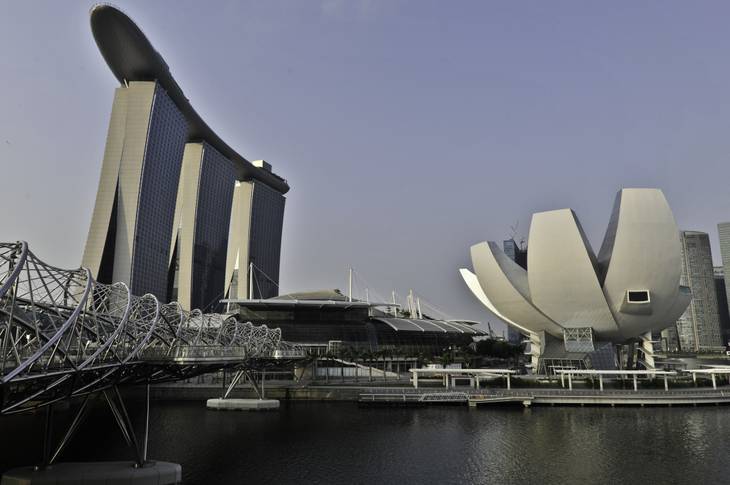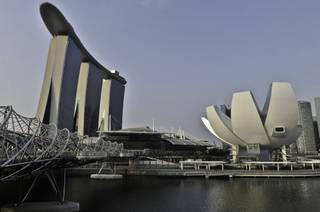
The Marina Bay Sands resort in Singapore is shown with the ArtScience Museum on the right and the convention center and retail area in the center.
VEGAS INC Coverage
Thirty-two hours.
That’s how long it took—straight—to get from my house to my hotel on Macau’s Cotai Strip during my recent trip to Asia.
An extremely long trip such as this illustrates why it’s so important for Las Vegas tourism officials to campaign for nonstop international flights to and from Asia.
And it would help, too, if federal travel officials were friendlier to international fliers.
On the 12-hour flight from San Francisco to Hong Kong, I thought about how much more appealing the trip to Las Vegas would be for those millions of financially capable Chinese tourists we want to visit our city if it were just a little easier to get here, and if they felt welcome when they arrived. My trip to Macau included a 90-minute flight from McCarran to San Francisco International. Because of that airport’s design, I had to leave the secure area when I arrived and go through the security checkpoint a second time before boarding my flight to Hong Kong.
During the past month, I’ve had two Transportation Security Administration experiences in California, one in San Francisco, the other at Los Angeles International Airport. Neither was good. At both, TSA agents snarl at you instead of speak to you. Even on my outbound flight from McCarran, I experienced a security agent who must have been a Marine drill sergeant before joining the agency. He barked nonstop about emptying all pockets of everything before being scanned, apparently another new rule the agency did little to publicize before implementing. That intimidating style is what earns the United States the reputation for being a hostile host. It’s one of the things the year-old Corporation for Travel Promotion, formed by the Travel Promotions Act, wants to change. It should be a relatively easy thing to do. Just hire people who can be informative without being belligerent, train agents to be friendly in their work and get rid of those who can’t perform.
Developing more direct flights is a little harder, especially with the economy down, airlines in financial recovery and Las Vegas having to compete increasingly with other attractive destinations.
There’s only one nonstop flight between Asia and Las Vegas today, Korean Air’s thrice-weekly operation between McCarran and Seoul. There used to be flights to and from Tokyo on Northwest and Japan Airlines and to and from Hong Kong on Singapore Airlines. Northwest was first with its Tokyo service, but it ended when Japan Airlines competed on the route. Not long after that started, Japanese tourism dropped when safety fears surrounding US military action in Iraq were in the news. Singapore’s service from Hong Kong was short lived because of the SARS scare.
As I sat on my flight to Hong Kong, I thought about how great it would have been to leave directly from and return to McCarran and cut out the West Coast stopover. The Las Vegas Convention and Visitors Authority and McCarran work in tandem to recruit air service. They know they’ll have the best chance for success lobbying foreign carriers because US-based airlines such as United, Delta and American are committed to flying from abroad to their hub airports so they can move passengers more efficiently through their networks. But foreign carriers can get an edge on their US counterparts by offering direct flights to a major resort city like Las Vegas.
To that end, it’s important that airline recruiters do everything they can to sell the city. They’ve had success with Canada, Mexico and Great Britain, mixed results with the rest of Europe, but very little success with Asia. They need to sell our entertainment amenities, such as the outdoors and the Grand Canyon, as well as our casinos and resorts.
It’s essential for the TSA to be a partner in that, not only for Las Vegas’ benefit but for the entire country’s tourism industry.
